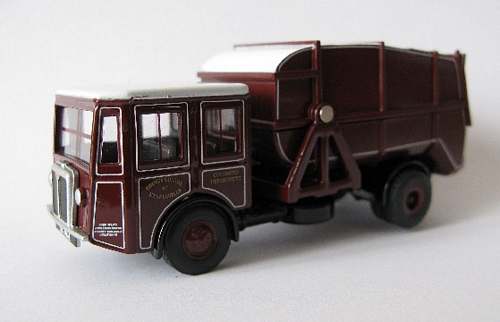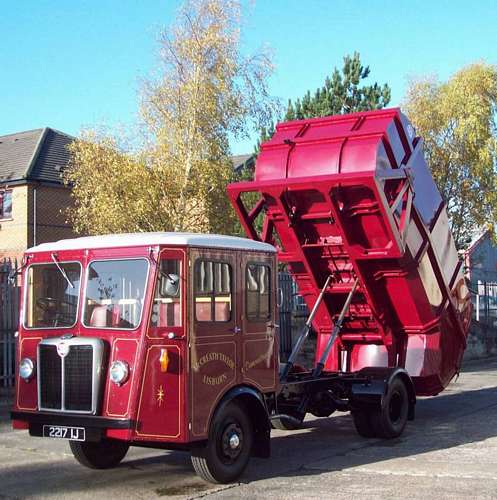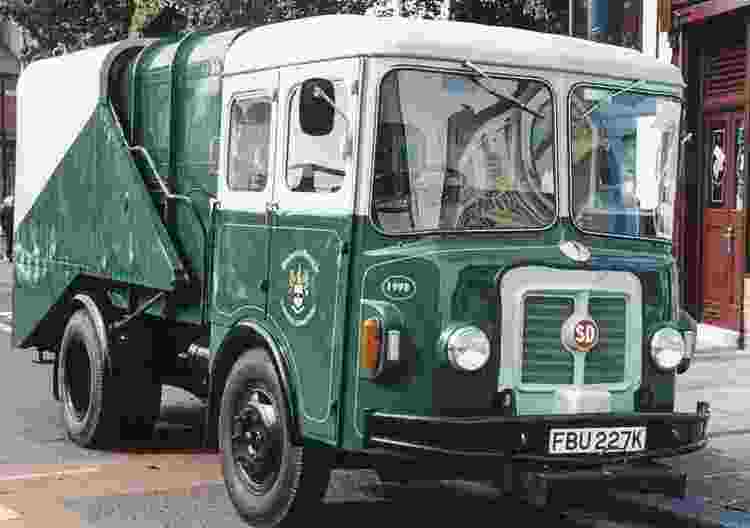Shelvoke & Drewry Enthusiasts’ Club Newsletter - Autumn 2023
Page 1
Those Amazing SD Freighters
Four photos have arrived recently of SD Freighter all on solid tyres, and I thought they’d make an interesting page shown together.
Probably The Most Photographed
Nigel Atha sent in this newspaper photo from Shepway Today showing the retored ex-Folkestone Freighter Reg. No. KP 7660. With the Title:- Bin there, done that.

The text reads:-
The way we were … this is one of the earliest 'bin lorries', to work on the streets of Folkestone. The photograph was sent to Shepway Today by John Fitch of Sturry whose father John, 'Jack' Fitch, an engineer is pictured.
Jack was employed by the former Shelvoke & Drewry company of Letchworth in Hertfordshire which manufactured commercial vehicles. The original covers on the dustcart were canvas, but were later made of steel sheet.
John say that the dustcart, which was manufactured in 1927, saw many years of service for the former Folkestone Borough Council collecting rubbish from local homes before it fell into ‘wrack and ruin.’ It was salvaged and re-built by a team of Shelvoke & Drewry apprentices and was entered in the London to Brighton run for commercial vehicles in the 1950’s.
A Very Early Freighter
Brads Ross provided this photo of one of the first Freighters. A raised platform body has been provided to accommodate any customer who already has a standard height loading dock where the low loading height wasn’t required.

Close To Home
Martin Blatch shared this photo of a Freighter designated 'Letchworth No. 2'. It is equipped with the early style canvas covers and in all probability replaced a horse drawn cart. Letchworth's Cleansing Departments yard was just a short distance from SD's works in Icknield Way on the opposite side of the road. It must have been pleasing for the company to not only secure the local council as a customer but also to receive a repeat order.

North Of The Border

Darren Ainsworth sent a link to this photo from the Visit Dunfermline Facebook page. Two operators stand alongside the Freighter which is fitted with twin rear wheels. It's also equipped with 'dustless shutters' which were opened by foot treadles. At the time a lot of the refuse consisted of ash from open fires and when the bins were tipped into the body inevitable a cloud of dust emerged. To some extent the shutter would reduce this. The text on the body appears to encourage householders to burn their vegetable waste to reduce rates.
On the Dunfermline page Charlie Kingour commented:-“ The bin lorry at the top was a nightmare to work with. As it filled up, you found yourself throwing the rubbish uphill, out of the bucket. Not easy if you're short. And with nothing to stop it, you often ended up wearing it when it fell back down, as you attempted to fill it right up, to save going to the tip, which you did frequently. You'd be lucky to get a street's worth in there.”
Page 2
Sorry – Your days are numbered my old mate!
By the Editor.

I’m finding it very hard to imagine as world in which the horse drawn cart was still a common sight on our roads. But in 1922 when the first SD Freighter appeared a horse drawn dustcart often still collected household refuse. According to Kaleidoscope of Shelvoke & Drewry (to which volume I acknowledge my indebtedness for much of the following information), the newly formed SD company was somewhat surprised when local authorities realised the potential for the Freighter as a refuse carrier.
Through their service inspectors and sales representatives S&D uncovered facts and figures in 1924 & 1925. At the time a horse cost about £80 or £100 to purchase and had a working life of about five years. The Freighter costing roughly £500 however was expected to last at least ten years.
It was known that three people filled about one refuse bin per week, and Tynemouth reported that per head of population between 3.66 cwt and 7.30 cwt of refuse was collected per year. Eastbourne replaced two horses and carts with a driver and one loader by one Freighter with a driver and two loaders and reported a 27% reduction in costs. Torquay calculated that using a Freighter was 31% per load cheaper than using a horse drawn cart, whilst St. Helens experienced a fall in the cost per ton of disposing of refuse of 9% Middlesborough compared the cost of using a Freighter against a Ford TT and disclosed a saving of 21%.
The side loading Freighter didn't supply any compression of the load and Councils, such as this example from Stockport, encouraged their customers to produce as little refuse as possible.

The SD Sales Representatives must often have been asked about the financial advantages of the Freighter as well as its advantages for driver and loaders. After the sad accidental death of Edward Asquith in 1926, Geoffrey Rackham was promoted to Sales Director and SD’s former factory representative in Australia, Rex Boundy, was appointed as Sales Manager. The task of calculating estimated cost savings was a complicated one and in 1928 Rex devised a double sided slide rule to allow the Sales Representatives to make rapid calculations. The slide rule measures approx 8” x 3” and states that it was manufactured by Foster Intruments of Letchworth.

Recently I’ve had the opportunity to examine one of these slide rules, since in our Facebook Group Paul Lordster posted photos. About thirty years ago Paul found this slide rule on a rubbish tip and had been unable to discover its use until he found us on the Internet.
I imagine these devices were given to each Sales Representative. They will have asked the prospective customer for five statistics:-
- The annual tonnage of refuse collected.
- The number of loaders used on each Freighter.
- The weight of refuse in cwts per loader in a day.
- The loaders’ wage in shillings per week
- The number of bins lifted by a loader in a day
On the front side the refuse in thousands of tons per year (1) was aligned with the number of proposed loaders (2), then from the lower scale against the amount per loader per day (3) the number of Freighters required was shown.

The reverse side has two sliding scales (numbered 80B & 80C)
First the top slide is aligned with the number of loaders (2) against the loaders' wages (4) and a figure coded as Z is given. On the lower scale the Z code is entered against the amount lifted per loader in cwts (3). or bins (5). The resulting figure is the cost in shillings per ton or per hundred bins in shillings.
An ingenious device to make the salesman calculations in the days before pocket calculators had been invented.
My thanks for the photos to Peter Johnston for the photo of his replica horse drawn dustcart to Shaun Taylor and to Paul Lordster for the other photos.
Page 3
Mrs. Freda Tassell
We were sorry to learn that Mrs. Freda Tassell had died peacefully in her sleep at the age of 98. Her Grandson, Tony, had kindly passed on the news. The funeral for Freda was on 24th July. Freda had a remarkable career at S&D lasting 45 years. I have previously produced the following account of Mrs. Tassell’s time at the Company.
Freda Tassell (SD 1942 – 1987)
Mrs. Freda Tassell was one of the first to respond to my request for people’s memories of working at Shelvoke & Drewry. Freda sent in this very interesting account of an entire working life at the Company.
From Welder To Cost Office Manager
By Mrs. Freda Tassell.
It was the Second World War that brought me to Letchworth and Shelvoke & Drewry. In September 1942, at the age of 18, I was sent from my home in Orsett, near Thurrock in Essex as a war worker. I was trained to become an electric welder, working with other girls who had also been called up. Some specialist men taught and helped us. Mr. Shelvoke was the Managing Director, and he used to regularly come round and ask us if we were enjoying our work. He used to put on social evenings for all the girls. We were welding manifolds and bends for Army trucks.


I was then moved into the office as a cost clerk, working with Peter Wright. We spent hours costing the latest secret weapon, the 4 man submarine, which were built entirely by S & D. There were no calculators in those days, and every single part, right down to the last nut and bolt, was costed manually.
When peace came in 1945 production of the submarines came to an end. The factory started building the tiller controlled Freighters once more, usually with a Chelsea type body. The following year, 1946, Mr. Davenport became the Managing Director. He was always a great help, and a friend to everyone.
Sadly Peter Wright died in the office in 1966, and I was asked to take his place. I ran the Cost Office for 21 years, with the help of four lovely ladies, until I retired in 1987, after 45 years with the Company, which was nearing its end. We costed every single vehicle that left the works.
I married my husband Alex Tassell in October 1945, and he returned to S & D after war service in the Royal Artillery. His father had worked in the Joiners’ Shop until he retired in 1940. He worked on all the models with wooden cabs. Alex initially worked on the chassis line, and then in the Service Dept. where he became a service inspector with Bill Martin, Alex Taylor, Mick Walker, Tom Pryke and Ken Jenkins. Sadly all these have now passed away with the exception of Alex Taylor.

For me, and my family, Shelvokes was a family oriented firm, as it was for many others. Alex’s brother, Eddie, also worked there, for over 20 years, at the No. 2 Factory. It was a sad day for me when I retired in 1987 – lots of tears were shed, apart from my husband and daughter, Gillian. S & D had been my life.
I kept in touch with Mr. Davenport after he’d retired and his wife Win gave me a copy of the ‘Sphere’, from October 1947, that describes the miniature submarines. I’m very proud of the part I played in the war effort.
Freda Tassell. 15th March 2003.
Page 4
The Model Scene
New From N’tastic Scale Models

Richard Dallimore, the proprietor of N’Tastic Scale Models, has announced that he has added the ‘W’ type Fore & Aft Tipper to his range of 3D printed resin models in N gauge ( 1/148). The model comes unpainted and in five sections. Richard has also told me that he intends to add other SD vehicles to this range.
Full details can be found on:- https://www.coppermineminiatures.co.uk/product-page/n-gauge-vehicles-1946-shelvoke-drewry-w-type-bin-lorry
Oxford Diecast News
Oxford Diecast have announced that work is underway to produce diecast models in OO scale (1:76) of the Dennis Eagle Olympus Refuse Collection Vehicle. This will only be the second refuse collection vehicle in their extensive range of model cars and commercial vehicles.

In writing about the proposed new model “Taff” reflected on the changes that have come about since Oxford Diecast produce their models of the ‘W’ type Fore & Aft tipper.
“This created problems as no examples were in existence but a body was found in a breaker’s yard and it took two days to measure the body, which I imagine including fighting with the brambles. The only vehicle available was a cesspool emptier which only had the single cab, but Oxford realise that it wasn’t difficult to create a crew cab from the dimensions of the single cab. At one point the company almost decided the project was too difficult and should be abandoned. Thank goodness it wasn’t!”

In 2023 a scanner is available to them which can measure all the dimensions of a vehicle and they have an existing Dennis Eagle Olympus body that they have scanned. How things have changed over fifteen years.
Taff notes that Oxford Diecast were highly amused when they receive a phone call from Peter Johnston asking if he could let him have the dimension of a ‘W’ type Fore & Aft tipper as he was restoring one.

You can find the full story on https://www.oxforddiecast.co.uk/…/more-rubbish-from-taff
Page 5
News Of Surviving Vehicles
Out & About This Summer
Paul Nicholls has informed us that his TZ Reg. No. JNN 463 K has been displayed at a number of rallies this Summer. The TBN Pakamatic owned by Keighley Bus Museum has also been seen at several events this year including the Bronte Gathering at Cullingworth.

Keighley Bus Museum Trust News
The Summer 2023 issue of the News magazine from the Keighley Bus Museum carried a letter that I had submitted, along with three photos showing the replica Tramocar at the Amberley Museum and the airport transfer bus.
“Dear Editor
When I received my copy of KBMT News Spring 2023 edition I was absolutely delighted to see the cover photo was of the 1972 Shelvoke & Drewry TBN Pakamatic Reg. N. FBU 227 K which is part of the Museum’s collection. I was an apprentice at S & D in the 1950’s and for the past twenty years I have been running the SD Enthusiasts’ Club.
Shelvoke & Drewry were a fairly small manufacturing company but their products were highly respected. Founded in 1922 by Harry Shelvoke & James Drewry in Letchworth Garden City, Hertfordshire, to produce a very unusual light lorry. Instead of a steering wheel the lorry was controlled by a handle termed a ‘tiller’ and the clutch pedal was replaced by a second tiller. It was said that anyone could learn to drive the lorry in just 30 minutes. The lorry attracted many customers as a refuse collection vehicle as the small diameter wheels allowed a low loading height. Some 50 chassis were purchased with bus bodies mostly for sea front duties, a replica is exhibited at the Amberley Museum in West Sussex.
After the Second World War S&D produced more conventional vehicles and the Pakamatic was launched in 1960. For twenty-two years the company also produced heavy duty fork lift trucks (1952 – 1974). From 1974 they produced a range of special purpose vehicles of which one was an airport transfer bus which sadly didn’t generate any further orders. The company encountered difficulties in the 1980’s and finally closed in 1991. Further details about the company may be found at www.shelvoke-drewry.co.uk”

Stephen Harrison posted this photo on Facebook of ‘W’ type Reg. No. RVO 157 at Newark Showground earlier this year, with a vintage tractor onboard.
Page 6
The Editor’s Page
The Way Things Were In The 1950’s

In August Campbell Spence posted in Facebook this delightful photo of an SD ‘W’ type with Chelsea type body, at work in Broughton Ferry, Dundee, Scotland. Pablo Raybound had found this slide among a number he was researching for other purposes.
It amazed me that a loader would be standing on the refuse, presumably to speed up the loading. The cab of this vehicle appears to have a storage compartment behind the driver since there isn’t a glass window. The hooks on the rear door may well have been used for sacks to carry waste paper or perhaps the vehicle carried its own waste bins.
Look What I’ve Got!

Ray Kilby sent in this photo of a printer’s block that his father, Tom Kilby, brought home from Shelvoke’s for him to play with over 60 years ago. It was used to print an advertising brochure for the ‘W’ type Fore & Aft tipper seen below. A reminder of how printing technology has moved on.

I liked this photo of an SPV WY Hydraulic Platform in service in Leicestershire sent in by Alan Warden.

All Change In Icknield Way
I am told that shortly the remaining part of the S&D works in Icknield Way is to be cleared for housing. This will include the demolition of the final office block built on the site. How sad that Ebenezer Howard’s vision of a Garden City providing homes for those working in Letchworth’s manufacturing industries is steadily losing all the companies that brought wealth to the town.
Facebook Group Membership
There are currently 944 members of the SD Enthusiast’s’ Club Facebook Group. Unfortunately only a very small proportion post news items or comments.
THANKS
As usual my thanks are due to all those who have sent in news items and photos. I have tried to acknowledge your contribution in the text of this Newsletter.
Brian - Editor.
The Shelvoke & Drewry Enthusiasts’ Club Newsletter is published four times a year on 1st March, 1st June, 1st September and 1st December. Items for inclusion may be e-mailed to me at: pinnerboy[at]btinternet.com
Next issue:- Winter 2023 will be published on 1st December 2023.